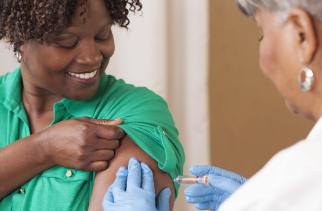Publicatie
Publication date
Impact of influenza vaccination in the Netherlands, 2007-2016: vaccinees consult their general practitioner for clinically diagnosed influenza, acute respiratory infections, and pneumonia more often than non-vaccinees.
Caini, S., Paget, J., Spreeuwenberg, P., Korevaar, J., Meijer, A., Hooiveld, M. Impact of influenza vaccination in the Netherlands, 2007-2016: vaccinees consult their general practitioner for clinically diagnosed influenza, acute respiratory infections, and pneumonia more often than non-vaccinees. PLoS One: 2021
Read online
Introduction
We aimed to develop an innovative population-based method to estimate the health effect of influenza vaccination based on electronic medical records collected within a general practitioner (GP)-based influenza surveillance system in the Netherlands.
Methods
In each season between 2006/07 and 2015/16, we fitted multilevel Poisson regression models to compare GP consultation rates for clinically diagnosed influenza, acute respiratory infections (ARI), pneumonia, and lower back pain (as a control) between vaccinated vs. unvaccinated individuals. Season-specific relative risks and 95% confidence intervals (CI) were pooled into summary risk ratio (SRR) through random-effects meta-analysis models. Analyses were stratified by patient age (<45, 45-59, 60-74, ≥75 years) and medical indication for the vaccine (any vs. none, subjects aged ≤60 years only).
Results
Overall, 12.6% and 21.4% of study subjects were vaccinated because of their age only or because of an underlying medical condition. Vaccine uptake declined over time, especially among subjects aged ≤74 years with medical indications for vaccination. Vaccinated individuals had significantly higher GP consultation rates for clinically diagnosed influenza (SRR 1.24, 95% CI 1.12-1.38, p-value <0.001), ARI (SRR 1.33, 95% CI 1.27-1.39, p-value <0.001), pneumonia (SRR 1.27, 95% CI 1.19-1.36, p-value <0.001), and lower back pain (SRR 1.21, 95% CI 1.14-1.28, p-value <0.001) compared to unvaccinated individuals.
Discussion
Contrary to expectations, influenza vaccinees have GP consultation rates for clinically diagnosed influenza, ARI and pneumonia that are 24-33% higher compared to unvaccinated individuals. The lower back pain finding suggests that the increase in consultation rates is partially caused by confounding. Importantly, considering the data are not laboratory-confirmed, our results cannot be linked directly to influenza, but only to respiratory illnesses in general.
We aimed to develop an innovative population-based method to estimate the health effect of influenza vaccination based on electronic medical records collected within a general practitioner (GP)-based influenza surveillance system in the Netherlands.
Methods
In each season between 2006/07 and 2015/16, we fitted multilevel Poisson regression models to compare GP consultation rates for clinically diagnosed influenza, acute respiratory infections (ARI), pneumonia, and lower back pain (as a control) between vaccinated vs. unvaccinated individuals. Season-specific relative risks and 95% confidence intervals (CI) were pooled into summary risk ratio (SRR) through random-effects meta-analysis models. Analyses were stratified by patient age (<45, 45-59, 60-74, ≥75 years) and medical indication for the vaccine (any vs. none, subjects aged ≤60 years only).
Results
Overall, 12.6% and 21.4% of study subjects were vaccinated because of their age only or because of an underlying medical condition. Vaccine uptake declined over time, especially among subjects aged ≤74 years with medical indications for vaccination. Vaccinated individuals had significantly higher GP consultation rates for clinically diagnosed influenza (SRR 1.24, 95% CI 1.12-1.38, p-value <0.001), ARI (SRR 1.33, 95% CI 1.27-1.39, p-value <0.001), pneumonia (SRR 1.27, 95% CI 1.19-1.36, p-value <0.001), and lower back pain (SRR 1.21, 95% CI 1.14-1.28, p-value <0.001) compared to unvaccinated individuals.
Discussion
Contrary to expectations, influenza vaccinees have GP consultation rates for clinically diagnosed influenza, ARI and pneumonia that are 24-33% higher compared to unvaccinated individuals. The lower back pain finding suggests that the increase in consultation rates is partially caused by confounding. Importantly, considering the data are not laboratory-confirmed, our results cannot be linked directly to influenza, but only to respiratory illnesses in general.
Introduction
We aimed to develop an innovative population-based method to estimate the health effect of influenza vaccination based on electronic medical records collected within a general practitioner (GP)-based influenza surveillance system in the Netherlands.
Methods
In each season between 2006/07 and 2015/16, we fitted multilevel Poisson regression models to compare GP consultation rates for clinically diagnosed influenza, acute respiratory infections (ARI), pneumonia, and lower back pain (as a control) between vaccinated vs. unvaccinated individuals. Season-specific relative risks and 95% confidence intervals (CI) were pooled into summary risk ratio (SRR) through random-effects meta-analysis models. Analyses were stratified by patient age (<45, 45-59, 60-74, ≥75 years) and medical indication for the vaccine (any vs. none, subjects aged ≤60 years only).
Results
Overall, 12.6% and 21.4% of study subjects were vaccinated because of their age only or because of an underlying medical condition. Vaccine uptake declined over time, especially among subjects aged ≤74 years with medical indications for vaccination. Vaccinated individuals had significantly higher GP consultation rates for clinically diagnosed influenza (SRR 1.24, 95% CI 1.12-1.38, p-value <0.001), ARI (SRR 1.33, 95% CI 1.27-1.39, p-value <0.001), pneumonia (SRR 1.27, 95% CI 1.19-1.36, p-value <0.001), and lower back pain (SRR 1.21, 95% CI 1.14-1.28, p-value <0.001) compared to unvaccinated individuals.
Discussion
Contrary to expectations, influenza vaccinees have GP consultation rates for clinically diagnosed influenza, ARI and pneumonia that are 24-33% higher compared to unvaccinated individuals. The lower back pain finding suggests that the increase in consultation rates is partially caused by confounding. Importantly, considering the data are not laboratory-confirmed, our results cannot be linked directly to influenza, but only to respiratory illnesses in general.
We aimed to develop an innovative population-based method to estimate the health effect of influenza vaccination based on electronic medical records collected within a general practitioner (GP)-based influenza surveillance system in the Netherlands.
Methods
In each season between 2006/07 and 2015/16, we fitted multilevel Poisson regression models to compare GP consultation rates for clinically diagnosed influenza, acute respiratory infections (ARI), pneumonia, and lower back pain (as a control) between vaccinated vs. unvaccinated individuals. Season-specific relative risks and 95% confidence intervals (CI) were pooled into summary risk ratio (SRR) through random-effects meta-analysis models. Analyses were stratified by patient age (<45, 45-59, 60-74, ≥75 years) and medical indication for the vaccine (any vs. none, subjects aged ≤60 years only).
Results
Overall, 12.6% and 21.4% of study subjects were vaccinated because of their age only or because of an underlying medical condition. Vaccine uptake declined over time, especially among subjects aged ≤74 years with medical indications for vaccination. Vaccinated individuals had significantly higher GP consultation rates for clinically diagnosed influenza (SRR 1.24, 95% CI 1.12-1.38, p-value <0.001), ARI (SRR 1.33, 95% CI 1.27-1.39, p-value <0.001), pneumonia (SRR 1.27, 95% CI 1.19-1.36, p-value <0.001), and lower back pain (SRR 1.21, 95% CI 1.14-1.28, p-value <0.001) compared to unvaccinated individuals.
Discussion
Contrary to expectations, influenza vaccinees have GP consultation rates for clinically diagnosed influenza, ARI and pneumonia that are 24-33% higher compared to unvaccinated individuals. The lower back pain finding suggests that the increase in consultation rates is partially caused by confounding. Importantly, considering the data are not laboratory-confirmed, our results cannot be linked directly to influenza, but only to respiratory illnesses in general.
Gegevensverzameling



